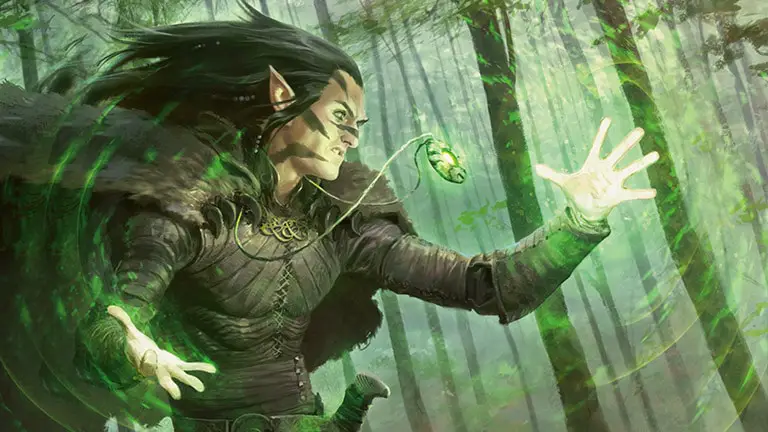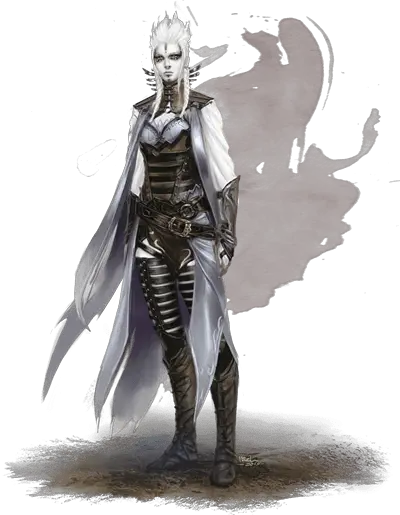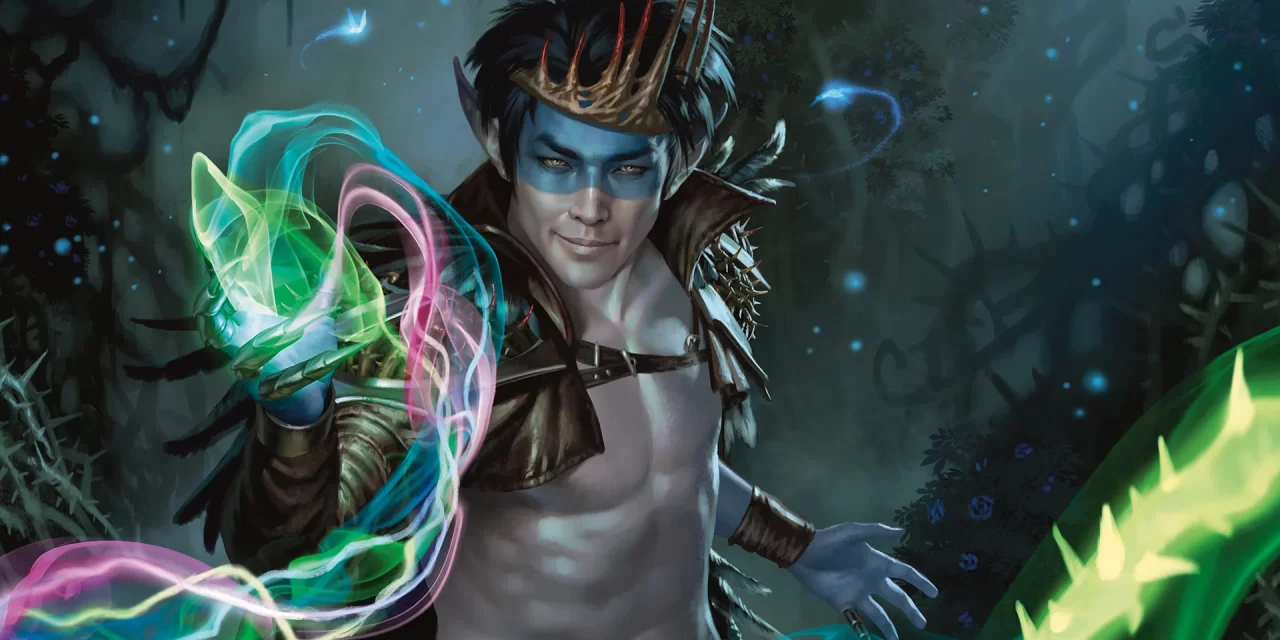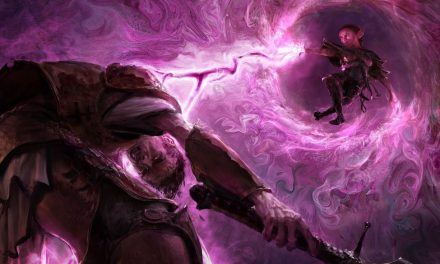Having trouble with pesky, invisible enemies? Tired of swinging blindly, disadvantaged?
Or are you outnumbered, wishing you had a way to virtually guarantee that you and your allies will successfully land attacks?
Well lucky for you there just happens to be an incredibly useful low-level spell that can solve all these problems!
Today we’re going over everything you need to know about the Faerie Fire spell in D&D 5e!
What is Faerie Fire in D&D 5e?
Faerie Fire is an area-of-effect spell that outlines all creatures in its 20-foot area in light. It requires concentration, is considered a debuff, and requires a Dexterity saving throw to avoid.
We’ve provided the official spell description from the 5e Player’s Handbook below for reference purposes.
Faerie Fire
Concentration
Level: 1st
Casting Time: 1 action
Range: 60 feet
Components: V
Duration: Up to 1 minute
School: Evocation
Attack/Save: DEX save
Damage/Effect: Debuff
Each object in a 20-foot cube within range is outlined in blue, green, or violet light (your choice). Any creature in the area when the spell is cast is also outlined in light if it fails a Dexterity saving throw. For the duration, objects and affected creatures shed dim light in a 10-foot radius.
Any attack roll against an affected creature or object has advantage if the attacker can see it, and the affected creature or object can’t benefit from being invisible.
What Does Faerie Fire Do in D&D 5e?
Faerie Fire is a classic spell that, if successful, covers the target in glowing light and gives attacks against them advantage for the spell’s duration.
Note that this also includes spell attacks like Chromatic Orb or Eldritch Blast!
Faerie Fire itself doesn’t inflict damage, but it has the potential to increase the number of hits (and crits!) your team is able to land per round.
The spell’s duration is one minute. That’s a whopping 10 rounds of advantage for you and your allies, provided you don’t lose concentration on the spell.
If you are going into an area where you are outnumbered by your enemies, or if they have a high AC, 10 rounds of advantage can make a world of difference in the outcome of the encounter. Especially if you or others in your group have multiple attacks per turn.
Personally speaking, if I have to decide between using Guiding Bolt (another iconic spell that gives advantage on the next attack against a target) and Faerie Fire, I will happily give up damage in exchange for giving my entire team advantage on their attacks.
But don’t forget that Faerie Fire is also great for revealing invisible objects as well. If you’re looking for some kind of invisible lever or another device, this handy spell might just save you a ton of headaches!
Who Can Learn Faerie Fire?
The Artificer, Bard, and Druid classes have Faerie Fire on their spell list.
Beyond these classes, Faerie Fire can also be used by Light Domain Clerics, Twilight Clerics, Archfey Warlock, and Swarmkeeper Ranger, as well as characters (like Drow Elves and Fairies) that gain Faerie Fire as a racial ability.
It can also be learned by any character who takes the Magic Initiate feat.
Describing Faerie Fire in Your Game
One of the best things about Faerie Fire is the seemingly endless flavor options!
This spell only requires a verbal component, so you can have your character say whatever phrase fits them best before casting.
My personal favorite, though, is deciding what the spell will actually look like once cast.
According to the spell description, Faerie Fire comes in one of three colors: blue, green, or violet. However, the cool thing about flavoring Faerie Fire is that it’s only limited by what you can imagine and what your DM will allow.
Any changes you make to Faerie Fire will be strictly cosmetic in nature, so your DM might be more inclined to allow them.
For example: if you’re playing a Druid, instead of making it a colored light, you could make incorporeal fireflies swarm around the affected creatures!

Tips for Using Faerie Fire
Before we go making everything shimmery and sparkly, let’s first go over a few handy tips that casters should know when using Faerie Fire.
After all, we don’t want any magical mishaps if it can be avoided!
Not So Friendly Fire
Remember that Faerie Fire does not discriminate between friend and foe.
This means that every creature in the affected area has to make the Dexterity saving throw. If your allies fail their save, enemy attacks will also have advantage on them.
And, yes, it’s possible to affect yourself with your own Faerie Fire if you aren’t careful!
That being said, you can use this to your advantage so long as your allies are on board.
If your Paladin or Cleric fails their save, enemies will be more likely to take advantage (pun intended) of this and focus their attacks on them, allowing them to soak up the damage instead of going after the squishier party members.
Combine Spell Effects!
Remember that you can use other spells to make Faerie Fire more effective against a stronger enemy.
For example, if another player at your table has access to the Hex spell, they can cast it on the target and select Dexterity as their chosen ability to impose disadvantage on saving throws.
If there’s one target in particular that you REALLY want to make sure gets hit by Faerie Fire, you might even consider hitting them with a Mind Sliver first. That will reduce their next saving throw by 1d4!
Placement Matters!
Last but not least, remember that careful placement is key when using Faerie Fire.
Since its area of effect is only a 20-foot cube, you want to be very precise and strategic you’re your placement to make sure you get the most out of what this spell has to offer.
Enemies tend to start encounters grouped up, so you might want to cast this quickly before everything gets all jumbled in combat. However, it might sometimes be better to bait enemies into a group and then let the sparkles fly!
Faerie Fire is a spell that can be incredibly useful to your party’s strategies. However, you want to be strategic with how you cast it as well!
Is Faerie Fire a Good Spell?
Even though the spell requires a Dexterity saving throw, it only has one. So once the target fails, Faerie Fire affects them for all 10 rounds (as long as the caster maintains concentration).
A 20-foot cube is enough space that you should have no trouble catching several enemies in the effect. While a lot of enemies tend to do reasonably well with Dexterity saves, the cost of failure can be steep.
If several enemies fail their saving throw against Faerie Fire (and your party quickly follows up on the shiny targets with advantage), it can have a huge impact on combat.
Not to mention, it also completely ruins the plans of enemies that like to go invisible or attack from hiding places!
Especially for a level 1 spell, Faerie Fire is an excellent option to keep prepared. It can turn entire combats around and is a great way to benefit both you and the rest of your party!
Storytime!
A great example of how useful Faerie Fire can be is the campaign that I’m currently a player in.
It was 4 vs 13, and our DM was understandably tired of us making easy work of his combats. He wanted to give us a challenge and minimize our casters’ abilities to maintain ample distance between our enemies.
Our enemies had us backed into a corner, and despite our best efforts, we were getting our butts handed to us.
Our Cleric was close to 0 hit points and our Warlock was already down. Things looked bleak and we were debating whether or not to cut our losses and try to escape.
Instead, our Fairy Cleric used Faerie Fire as a last-ditch effort to put the odds back in our favor since all of our enemies were grouped closely together in the small room.
It paid off beautifully.
The look of disbelief and frustration on our DM’s face as enemy after enemy failed their saving throws was SO satisfying.
In the end, 9 of the 13 enemies failed their throws (thank you, Dice Gods!) and our Paladin and Barbarian made quick work of most of them while the Cleric revived our Warlock and took out the rest.
3 rounds later, we were victorious!
It was a really epic moment, all made possible by a level-one Faerie Fire spell.

Faerie Fire 5e – Frequently Asked Questions
Before we wrap up this article, let’s go over some of the common questions players have about the Faerie Fire spell in D&D 5e.
As always, if you have questions that we haven’t answered in this guide, reach out in the comments. We’re happy to help you out!
How Does Faerie Fire Counter Invisibility?
So, typically an invisible creature gets advantage on its attack rolls and attacks against it are at disadvantage.
Faerie Fire neutralizes any benefit that an affected creature is getting from its invisibility though. While you can’t necessarily see the creature themselves, you’re able to see the sparkly lights that are stuck to them which helps you get around the whole “visibility problem.”
Where you were previously at disadvantage with your attacks against it, those attacks are now at advantage!
(Side note: there are a lot of arguments about whether those attacks would be at advantage or if they would be normal due to advantage canceling out the disadvantage. We’re going with what rules-boss Jeremy Crawford said here.)
How does Faerie Fire Interact with Darkness?
Since the affected target sheds dim light in a 10-foot radius, this spell can also be used to illuminate dark areas.
Faerie Fire doesn’t just target creatures, it also outlines obstacles and objects in the room so it could also come in handy for finding something in a dark room that you otherwise might miss.
Because Faerie Fire expends a spell slot and only lasts one minute, I suggest you save your spell slots in favor of cantrips like Dancing Lights that can produce similar results if your goal is just to illuminate an area.
It’s important to note, Faerie Fire does not do much against magical darkness when cast at first level. The Darkness spell will counter any source of light (magical or non-magical) that is cast at level 2 or lower.
To combat this, you would need to cast Faerie Fire using a level 3 spell slot at minimum. But with no other benefit from using a higher-level spell slot, that’s pretty inefficient…
Does Faerie Fire Always Give Advantage?
Being able to gain advantage on attacks against multiple enemies is incredible. It makes this spell really shine (even beyond its description!)
Just note that you will still have to be able to see the target to get advantage on your attacks against it.
That’s an important part of the effect that you don’t want to gloss over. As long as you can see the affected creature/object and it can’t benefit from being invisible, you’ll have advantage.
For example, you might have cast Faerie Fire and affected several enemies. However, one of them uses a spell or feature that causes you to be temporarily blinded. Since you can’t see the target (even though they’re affected by Faerie Fire), the advantage would not apply to cancel out the disadvantage you’re at for being blinded.
I’d recommend also checking out my other article that covers the ins and outs of how advantage and disadvantage work in D&D 5e!
Conclusion – Faerie Fire in D&D 5E
Faerie Fire is a great spell to have in your arsenal, but it is one of those spells that can be useless if poorly executed. So long as it’s used strategically, Faerie Fire can be a very useful spell and can significantly impact the outcome of an encounter.
Personally, I always find myself making space on my spell list for this option if I have it available to me. It’s been too useful on too many occasions to skip!
We’d love to read your opinion on this classic spell in the comments below. How have you used Faerie Fire in your games?
Don’t forget to sign up for the Tabletop Joab newsletter! It’s the best way to get all the latest player guides, DM Tips, news, reviews, and more for D&D 5e right to your inbox!
You can also follow Tabletop Joab on Facebook and Twitter.
If you found this article helpful and want to support the site, you can buy me a coffee here! (It’s not expected, but very appreciated!)









